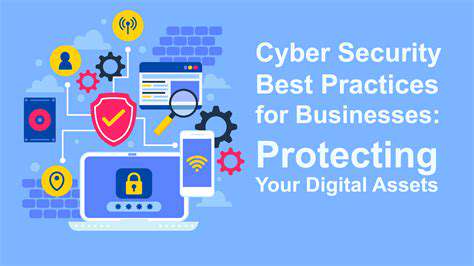Guide to Learning Cybersecurity Basics
Essential Concepts: Protecting Your Digital Assets

Understanding Confidentiality
Confidentiality is a cornerstone of data security, ensuring that sensitive information is accessible only to authorized individuals. This involves implementing robust access controls and encryption protocols to protect data from unauthorized disclosure. Maintaining confidentiality is crucial in safeguarding personal information, intellectual property, and financial records. Effective strategies involve restricting physical access to sensitive locations and utilizing strong passwords and multi-factor authentication.
Many organizations now use sophisticated encryption methods to scramble data, making it indecipherable to anyone without the proper decryption key. This added layer of security plays a vital role in safeguarding sensitive information during transmission and storage.
Integrity of Data
Data integrity focuses on ensuring that information is accurate, complete, and trustworthy. This means safeguarding against unauthorized alterations, modifications, or deletions that could compromise the reliability and validity of the data. Maintaining data integrity is paramount in preventing errors and ensuring decision-making is based on reliable information. It is especially important for financial transactions, medical records, and legal documents, where accuracy is critical.
Regular audits, version control systems, and data validation checks are essential components of an effective integrity strategy. Robust security policies and procedures should be implemented to deter and detect any attempts to corrupt or manipulate data.
Availability of Resources
Ensuring data availability means guaranteeing authorized users have reliable access to the information they need, when they need it. This includes redundancy planning, disaster recovery procedures, and continuous monitoring of systems. The consequences of data unavailability can be significant, leading to lost productivity, financial losses, and reputational damage.
Effective strategies for maintaining availability involve redundant systems and data backups, along with implementing a well-defined disaster recovery plan. These measures provide a safety net in the event of system failures or unexpected disruptions.
Authentication and Authorization
Authentication verifies the identity of a user or system. This is a crucial step in controlling access to sensitive information and resources. Various methods, such as passwords, biometrics, and multi-factor authentication, are used for verifying identity. Different users and systems are granted different levels of access based on their roles and responsibilities.
Authorization, the process of granting specific access rights to authenticated users and systems, is critical to preventing unauthorized access to sensitive data.
Access Control Measures
Robust access control mechanisms are fundamental to protecting sensitive information. This includes employing various methods to restrict access to specific data and resources, such as firewalls, intrusion detection systems, and access control lists. These measures are essential in preventing unauthorized individuals from gaining access to information they should not have. This often involves creating a multi-layered security system to provide an extra level of defense.
Regular security assessments and reviews are essential to ensure the effectiveness of access control measures and to adapt to emerging threats and changing business needs. Comprehensive policies and procedures should be put in place.
Risk Assessment and Mitigation
A thorough risk assessment is critical to identifying potential security vulnerabilities and threats. This involves identifying assets, potential threats, and the likelihood of these threats exploiting vulnerabilities. Identifying weaknesses allows for a proactive approach to mitigating risks. By assessing potential risks, organizations can take steps to minimize the impact of security breaches and maintain the confidentiality, integrity, and availability of their information assets.
Implementing effective security controls based on the risk assessment provides a proactive approach to security, allowing organizations to prepare for potential threats and maintain a strong defense against unauthorized access and data breaches.
Common Threats: Knowing Your Enemy

Malicious Software (Malware)
Malware encompasses a wide range of harmful software designed to infiltrate and damage computer systems. This includes viruses, worms, trojans, ransomware, and spyware, each with its own unique method of attack. Understanding the different types of malware and how they operate is crucial for recognizing potential threats and implementing appropriate security measures. These malicious programs can steal sensitive information, disrupt operations, and even hold systems hostage, demanding a ransom for their release.
Phishing Attacks
Phishing is a social engineering tactic where attackers impersonate legitimate entities, such as banks or social media platforms, to trick users into revealing personal information. These fraudulent emails, messages, or websites often appear authentic, making them particularly effective. Be wary of unsolicited emails asking for passwords, logins, or financial details. Scrutinize links carefully, and always verify the legitimacy of a request before responding or clicking on a link. Robust security awareness training for employees is essential to mitigate this type of attack.
Denial-of-Service (DoS) Attacks
Denial-of-service attacks overwhelm a system or network with excessive traffic, making it unavailable to legitimate users. These attacks can cripple essential services, leading to significant downtime and lost productivity. Preventing a DoS attack often involves robust network infrastructure and proactive security measures. A robust firewall and intrusion detection systems are crucial components of a defense strategy. Also, considering traffic filtering and load balancing measures can help mitigate the risks.
Insider Threats
While often overlooked, insider threats pose a significant security risk. Malicious or negligent insiders can intentionally or unintentionally compromise sensitive information or disrupt operations. Careless handling of data and weak access controls can lead to costly breaches. Robust access management policies and strict adherence to data handling procedures are vital to minimize this risk. Monitoring user activity and implementing regular security audits are essential components of an effective strategy.
Social Engineering
Social engineering exploits human psychology to manipulate individuals into divulging sensitive information or performing actions that compromise security. Attackers often use persuasion, deception, or intimidation to gain access to confidential data or systems. Recognizing social engineering tactics and implementing appropriate security protocols are critical steps. Educating employees about the various social engineering tactics used by attackers is an important proactive measure. This includes verifying the identity of the person requesting information or assistance before providing any sensitive data.
Data Breaches
Data breaches are the unauthorized access, disclosure, or use of sensitive data. This can compromise personal information, financial records, and intellectual property. The consequences of a data breach can be severe, impacting reputations, finances, and legal standing. Strong data encryption techniques and secure data storage practices are vital. Regular security assessments and vulnerability scans are essential to proactively identify and address potential weaknesses in your systems. Implementing and enforcing robust security policies is paramount.
Hot Recommendations
- How to Stay Productive While Working Remotely
- Tips for Managing Conflict with Coworkers
- Entrance & Certification Exams (升学考试)
- How to Improve Your Storytelling Skills (Speaking)
- How to Find Profitable Side Hustles
- Tips for Preparing for the TOEFL iBT Home Edition
- Guide to Switching Careers from [Industry A] to [Industry B]
- How to Run an Effective Hybrid Meeting
- Tips for Marketing Your Side Hustle on Instagram